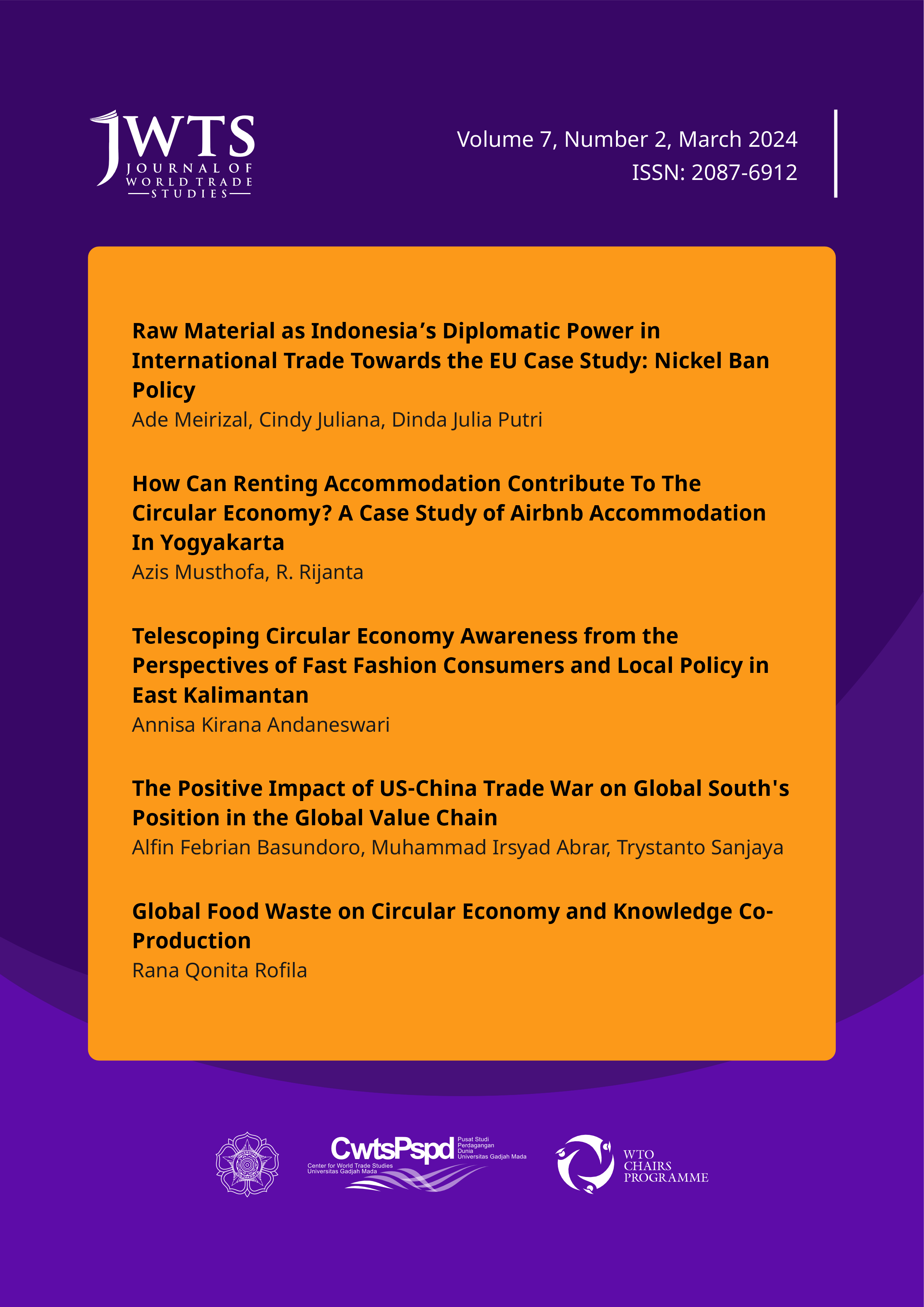Abstract
Along with sustainability paradigms revolve among the global society, Circular Economy (CE) appears as a new economic model that is compatible with this paradigm. Globally, there have been numerous research related to Circular Economy, including replacing fast fashion with circular fashion. The fashion sector was responsible for approximately 2.1 billion metric tons of Green House Gas (GHG) emissions, amounting about 4% of the global total. Emissions are exacerbated by fast fashion due to the make-take-dispose system implemented at a rapid pace. Unfortunately, the issue of fast fashion remains underdeveloped, especially in the local context. This paper examines Circular Economy awareness from fast fashion consumers and local policy In East Kalimantan to provide a picture of the local context. The authors used open questionnaires to collect responses from fast fashion consumers and stores (H&M, Matahari, and Uniqlo) relating to the dimensions of the Circular Economy. To capture the local policy context, this research uses policy content analysis from the National Medium Term Development Plan (RJPMN 2020-2024) to the Regional Medium Term Development Plan (RJPMD) and its derivative regulations in East Kalimantan. This study found that there is a lack of awareness by fast fashion consumers, which can be seen from the reluctance of customers and stores adapting to CE dimensions. Circular economy has been internalized through national development planning harmonized regulation at the local level. East Kalimantan Development Planning emphasized more on economic growth by generating a creative economy instead of transforming the linear economy into a Circular Economy.
References
Balanay, R., & Halog, A. (2019). Tools for circular economy. Circular Economy in Textiles and Apparel, 49–75. doi:10.1016/b978-0-08-102630-4.00003-0
Best, A., Langsdorf, S., Duin, L., & Araujo, A. (2022). Assessment of resource nexus-related challenges and opportunities in the context of the European Green Deal. Background report for the EEA Briefing “Applying a ‘resource nexus’ lens to policy: opportunities for increasing coherence.
Berg, A. G. (2020). Fashion on Climate : How The Fashion Industry can Urgently Act to Reduce its Greenhouse Gas Emission. www.Meckinsey.com .
Braungart, M., McDonough, W., & Bollinger, A. (2007). Cradle-to-cradle design: creating healthy emissions–a strategy for eco-effective product and system design. Journal of cleaner production, 15(13-14), 1337-1348.
Bruce, M. & Kratz, C. (2007). Competitive Marketing Strategies of Luxury Fashion Companies. Fashion
Marketing Contemporary Issue 2nd Edition Elsevier.
De Angelis, R. & De Angelis, R. (2018) Sustainable Development, Corporate Sustainability and the Circular Economy, Business Models in the Circular Economy. doi: 10.1007/978-3-319-75127-6_2
Dercon, S. (2014). Is green growth good for the poor?. The World Bank Research Observer, 29(2), 163-185.
Esposito, M., Tse, T., & Soufani, K. (2018). Introducing Circular Economy: New Thinking with Managerial and Policy Implications. California Management Review, 1-15.
Gabriel, Y & Lang, T. (2006). The Unmanageable Consumer. Thousand Oaks, CA: SAGE.
Geissdoerfer, M., Savaget, P., Bocken, N.M.P., & Hultink, E.J. (2017). The Circular Economy : A New Sustainability Paradigm . Journal of Cleaner Production (143), 757-769
Geng, Y., & Doberstein, B. (2008). Developing the circular economy in China: Challenges and opportunities for achieving'leapfrog development'. The International Journal of Sustainable Development & World Ecology, 15(3), 231-239.
Ghemawat, P & Nueno, J.L. (2006). Zara: fast fashion. Boston: Harvard Business School Publishing
Boston.
Kristianto, A. H. & Nadapdap, J. P. 2021. Dinamika Sistem Ekonomi Sirkular Berbasis Masyarakat Metode Causal Loop Diagram Kota Bengkayang. Sebatik. 25(1). pp. 59–67. doi: 10.46984/sebatik.v25i1.1279.
Kristianto, A. H., br Siahaan, S. V., & Vuspitasari, B. K. (2022). Potensi Pengembangan Ekonomi Sirkular Kerakyatan Dan Solusi Permasalahan Sampah Tidak Terkelola (Studi Kasus Desa Sungai Duri Kabupaten Bengkayang. Jurnal Maneksi, 11(1), 231-236.
Khompatraporn, C. (2021). Circular supply chain management. An Introduction to Circular Economy, 419-435.
Lanau, M., & Liu, G. (2020). Developing an urban resource cadaster for circular economy: A case of Odense, Denmark. Environmental science & technology, 54(7), 4675-4685.
Li, J., Choi, T., & Cheng, T.C. (2013). Mean Varian Analysis of of Fast Fashion Supply Chain Return with Policy. IEEE Transaction on System: Man and Cybernatic System, 1-13.
Li, Y., Zhao X., Shi, D., & Li, X. (2014). Governance on Sustainable Supply Chain in The Fast Fashion Industry. European Management Journal. 32(5). 823-836.
Lyle, J. T. (1996). Regenerative design for sustainable development. John Wiley & Sons.
Niinimäki, K., Peters, G., Dahlbo, H., Perry, P., Rissanen, T., & Gwilt, A. (2020). The Environmental Price of Fast Fashion. Nature Review: Earth and Environment. 1, 189-200

This work is licensed under a Creative Commons Attribution-NonCommercial-ShareAlike 4.0 International License.

